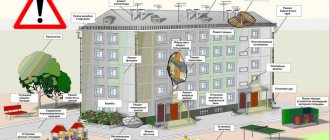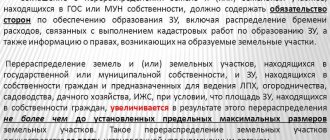Responsibility for violations of land legislation: how to be a law-abiding landowner?
The most common violation is unauthorized occupation of a land plot, liability for which is provided for in Article 7.1 of the Code of Administrative Offenses of the Russian Federation (hereinafter referred to as the Code of Administrative Offenses of the Russian Federation). The share of such violations is 75% of the total number of violations of land legislation requirements identified by the Rosreestr Office in the Vologda Region.
The practice of carrying out measures for state land supervision shows that unauthorized occupation of land most often occurs during construction or when fencing the territory. Citizens often do not respect the boundaries of land plots and install fences or buildings on the territory of other people's land plots.
In addition, when purchasing a land plot, the copyright holder should make sure that the desired intended use of the site is possible, as well as that fences, buildings and structures are located within the established boundaries. By becoming the owner of a land plot, a person automatically acquires not only the rights, but also the obligations to use the land plot within established boundaries.
For unauthorized occupation of a land plot or part of a land plot, Article 7.1 of the Code of Administrative Offenses of the Russian Federation establishes penalties in the amount of at least 5 thousand rubles for citizens and at least 100 thousand rubles for legal entities and individual entrepreneurs. Also, the fine can be calculated taking into account the cadastral value of the land plot (if any) and its size can be significantly higher than the fixed amount determined by the sanction of this article.
In addition to a fine, an order is issued to the person who committed the offense, which sets a period within which the violation must be eliminated. After this period, inspectors conduct an additional inspection. In case of failure to comply with the order within the established period, administrative measures in the form of bringing to administrative responsibility are applied to the violator. In addition, such person is issued a new order with a new deadline for elimination.
It should be noted that the actual use of the land plot must be confirmed by the relevant title documents for the land.
Citizens often do not notice that they have unauthorizedly increased their land plot, but arguments about ignorance do not relieve them of responsibility before the law. It should be understood that the land cannot be “nobody’s”, therefore, before occupying any plot or building something, you need to formalize your right to own it in the manner prescribed by law. You can contact the local government, or resolve disputes with your neighbors.
Entering information about boundaries into the Unified State Register of Real Estate (hereinafter referred to as EGRN) increases the protection of property rights and helps to avoid problems due to possible land disputes. Information about the presence or absence of information about the boundaries of land plots can be seen on a public Internet resource - a public cadastral map (https://pkk5.rosreestr.ru), or by requesting an extract from the Unified State Register of Real Estate on the main characteristics of the property.
Another common offense is the non-compliance of the use of a land plot with its intended purpose in accordance with its belonging to one or another category of land and (or) types of permitted use of the land plot, information about which is contained in the Unified State Register of Real Estate. Owners of land plots often do not pay attention to the type of permitted use of the site, believing that it is their property, and they, as owners, can perform any actions with it. However, such an opinion may lead to a violation of the requirements of land legislation.
The minimum fine for such violations for citizens is 10 thousand rubles, for legal entities - 100 thousand rubles.
Please note that the owner has the right to change the type of permitted use of the land plot. To clarify what types of uses are provided for by the rules of land use and development in the territorial zone in which this land plot is located, which are usually posted on the official website of the local government body, this information can also be obtained by contacting the relevant local government bodies. Any type of permitted use from the types provided for by zoning of territories is chosen by the copyright holder independently, without additional permits and approval procedures. At the same time, in order to use a land plot for a different purpose, it is necessary to make changes to the Unified State Register of Real Estate. Only after making these changes can we talk about the legality of using the land for a different purpose.
Another category of violations is the failure to use land plots intended for housing or other construction within the period established by law. Signs of such a violation are the absence of capital construction projects and construction work.
For this violation, liability in the form of a fine is also established. The fine for this violation may be at least 20 thousand rubles for citizens, and at least 400 thousand rubles for legal entities. In addition, the fine for this offense can be calculated taking into account the cadastral value of the land plot and can be significantly greater than the specified amounts.
In order to protect themselves from being brought to administrative liability in the form of significant penalties, we recommend that landowners and land users take measures aimed at independently identifying and eliminating violations of the requirements of land legislation.
Press service of the Rosreestr Office for the Vologda Region
The size of the plot is larger than in the documents, or there are no documents at all
In both cases, the same result is an accusation of unauthorized seizure of land. This problem is often faced by those who neglected land surveying. If the boundaries of the plot diverge from the data of the public cadastral map, then problems await the owner.
If the title documents were received a long time ago and have not been preserved, in some cases it will simply be impossible to prove ownership of the land.
An order will be issued to release the illegally seized land. In addition, in accordance with Article 7.1 of the Code of Administrative Offenses, a citizen will have to pay a fine in the amount of 1% to 1.5% of the cadastral value of illegally occupied land, and if such has not been determined - from 5,000 to 10,000 rubles.
Contents of land offenses
A land offence, like any other offence, is characterized by four elements: the object, the subject, the objective side and the subjective side of the offence. Liability for an offense can only arise if all four elements are present; the absence of at least one of them excludes liability.
The object of a land offense is public relations in the field of protection and use of land. The specific subject of the offense is a specific land plot, land regulations, rights of owners, possessors, users, and tenants of land. The objective side of a land offense is the specific acts of a violator who encroaches on the land interests of participants in land relations, resulting in a violation of the legal rights of individuals and legal entities and causing them harm. The objective side of a land offense is characterized by the presence of three elements: illegality of behavior; causing or real threat of causing harm, or violation of other legal rights of participants in land legal relations; a causal connection between the unlawful behavior and the harm caused or the real threat of causing such harm.
Subjects of land offenses are citizens or legal entities who have violated the norms of land legislation (they can be citizens of the Russian Federation and other states, as well as foreign enterprises and organizations). The subjects of the offense are also officials or senior employees of enterprises, organizations, institutions, including government ones. The composition of the subjects of a land offense depends on the type of offense. Thus, the subjects of disciplinary and material liability are officials and employees of enterprises and organizations, criminal – officials and citizens, administrative and civil liability – citizens, officials and legal entities. The subjective side of a land offense is the mental attitude of the subject to the act being committed, that is, how the offender relates to the act being committed. The subjective side is characterized by the guilt of the offender (except for cases of responsibility of the owner of a source of increased danger). The law provides for two forms of guilt: intent and negligence. A land offense is intentional when the offender foresees the onset of harmful consequences of his behavior and desires (direct intent) or consciously allows (indirect intent) them. Carelessness (negligence) is of two types: arrogance (frivolity) and negligence. Arrogance occurs when a person who violated the requirements of the law foresaw the socially harmful consequences of his activities, but frivolously expected to avoid them. Negligence is manifested in the fact that a person did not foresee the occurrence of harmful consequences, although he should have and could have foreseen them.
Misuse or non-use of the site
In the real estate register, each plot is assigned its intended purpose, which must be observed: industrial production cannot be carried out on a plot for individual housing construction, a garden plot is not intended for the construction of multi-storey buildings, etc.
Violation of the intended purpose, or “idleness” of the site may entail liability for the owner. In accordance with Article 8.8 of the Code of Administrative Offenses, for misuse of land, citizens are subject to a fine in the amount of 0.5% to 1% of its cadastral value, but not less than 10,000 rubles .
For non-use of land - a fine of 0.3% to 0.5% of the cadastral value, but not less than 3,000 rubles.
Disciplinary liability for land offenses, subjects of disciplinary liability
The concept of disciplinary liability is regulated by the current land legislation and provides for such legal liability that arises in cases of misconduct and offenses that were directly related to the work activities of the subjects of the violation.
Disciplinary liability for offenses in the field of land relations is considered less harmful than offenses that entail financial damage. Such crimes are most often classified as standard administrative violations.
Disciplinary liability is considered a measure of punishment for officials who committed a violation in the performance of their direct official duties. Therefore, the norm of land law in this case is also considered a labor norm for certain persons.
Taking into account the specifics of labor and land law, the subjects bearing disciplinary liability are the following:
- enterprises and their employees, whose responsibilities are distributed in the order of subordination;
- institutions and their employees, subject to division of responsibility in the order of subordination;
- organizations and manufacturing companies.
The activities of such organizations and institutions are most often associated with economic and production activities in the areas of industrial production, agricultural work, construction, etc. However, the offense that entails disciplinary liability must be associated with a qualitative deterioration in the ecological state of the environment.
All employees and officials of any enterprises, regardless of the form of ownership of the institution, bear disciplinary liability. Therefore, the subject of liability can be people in the public service or those who work in organizations created on a commercial basis.
Corruption of the earth
Violation of sanitary standards during the construction of bathhouses and street toilets, dumping of waste on site, unauthorized excavation of pits, etc.
- all this will be considered damage to the top fertile layer of the earth. For these actions, in accordance with Article 8.6 of the Code of Administrative Offenses, citizens are subject to a fine of 3,000 to 5,000 rubles. In addition, an order will be issued to eliminate violations and reclaim the land. For ignoring it, according to Article 8.7 of the Code of Administrative Offenses, a citizen faces a fine of 20,000 to 50,000 rubles.
As you can see, there are many restrictions that any land owner must comply with if he does not want problems with the law.
What do you think, which of these restrictions are really necessary and which are useless?
Which ones would you personally remove and which ones would you add? Please share your opinion in the comments. If you liked the article, please share it on social networks. Unlock access to the private part of Clerk with a Premium subscription. Get hundreds of webinars and online courses, unlimited consultations and other proprietary content for accountants.
Hurry up to subscribe with a 20% discount until October 15, 2021. Read more about “Premium” here.






